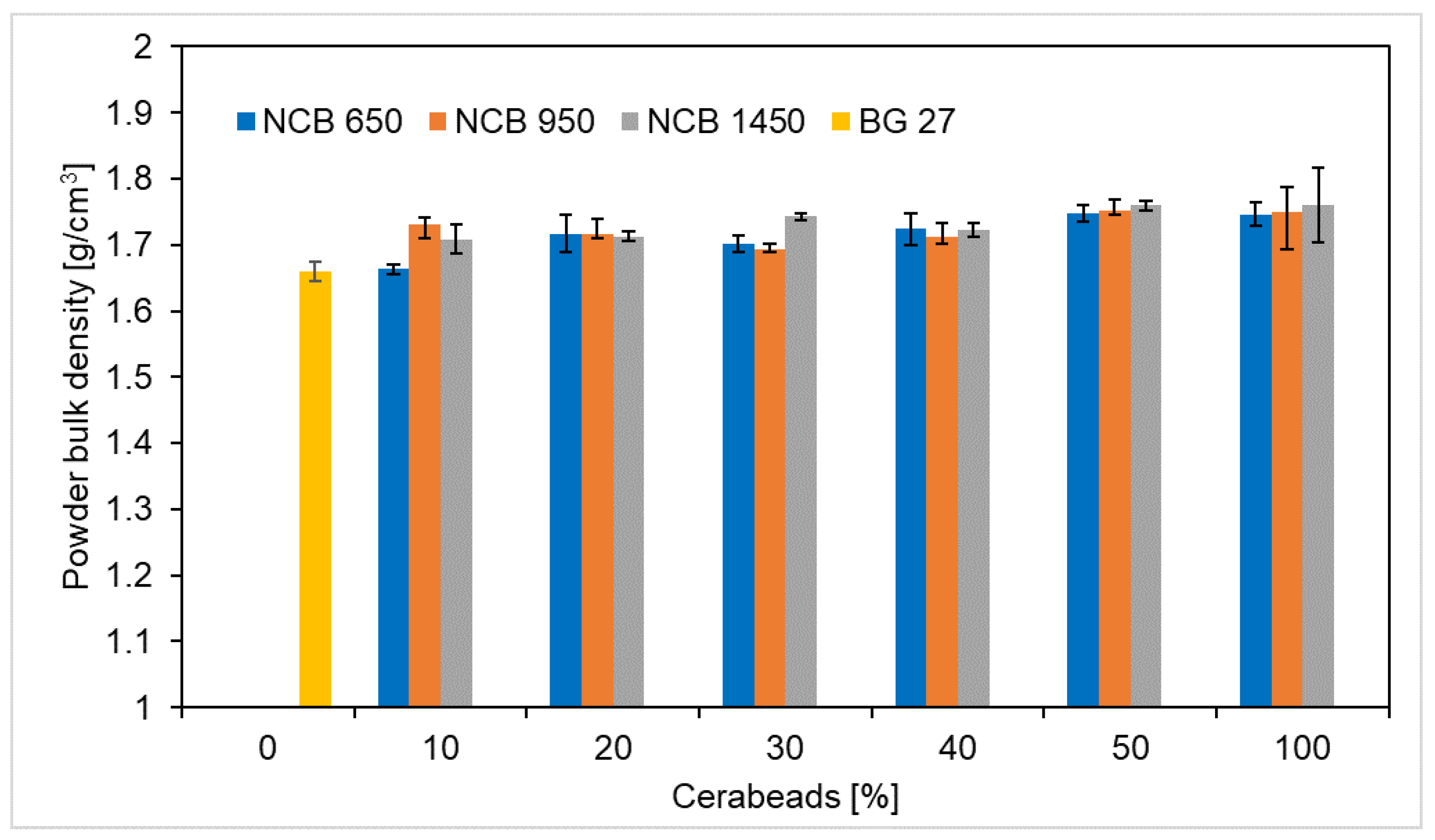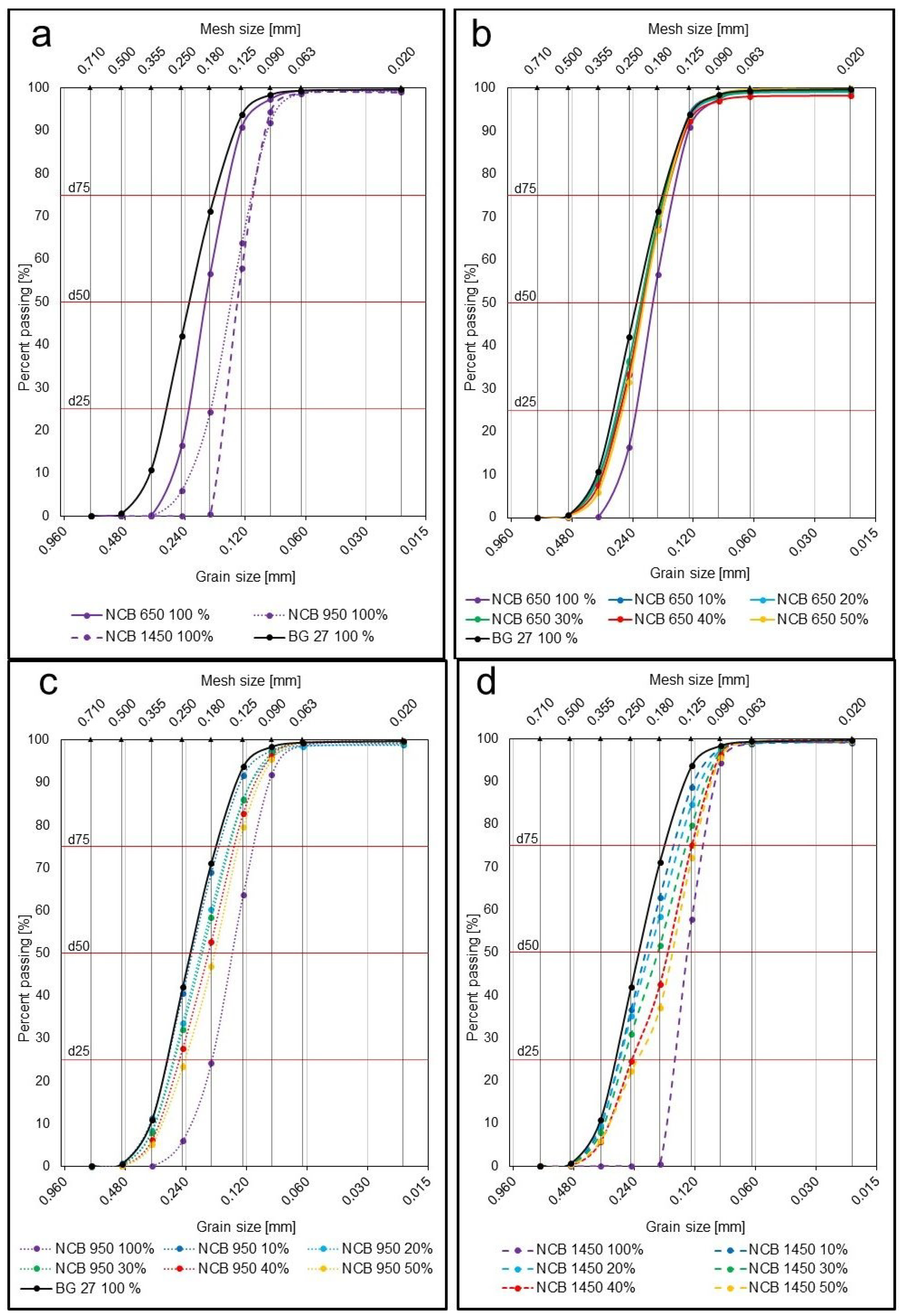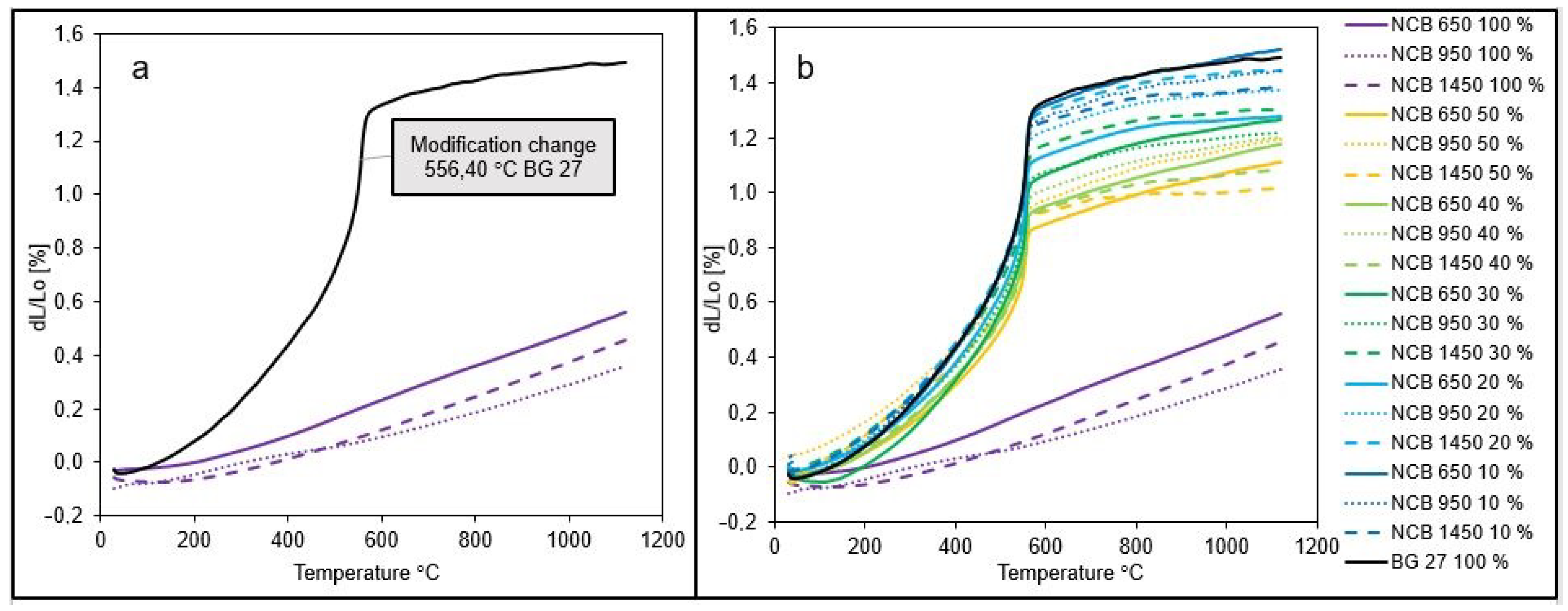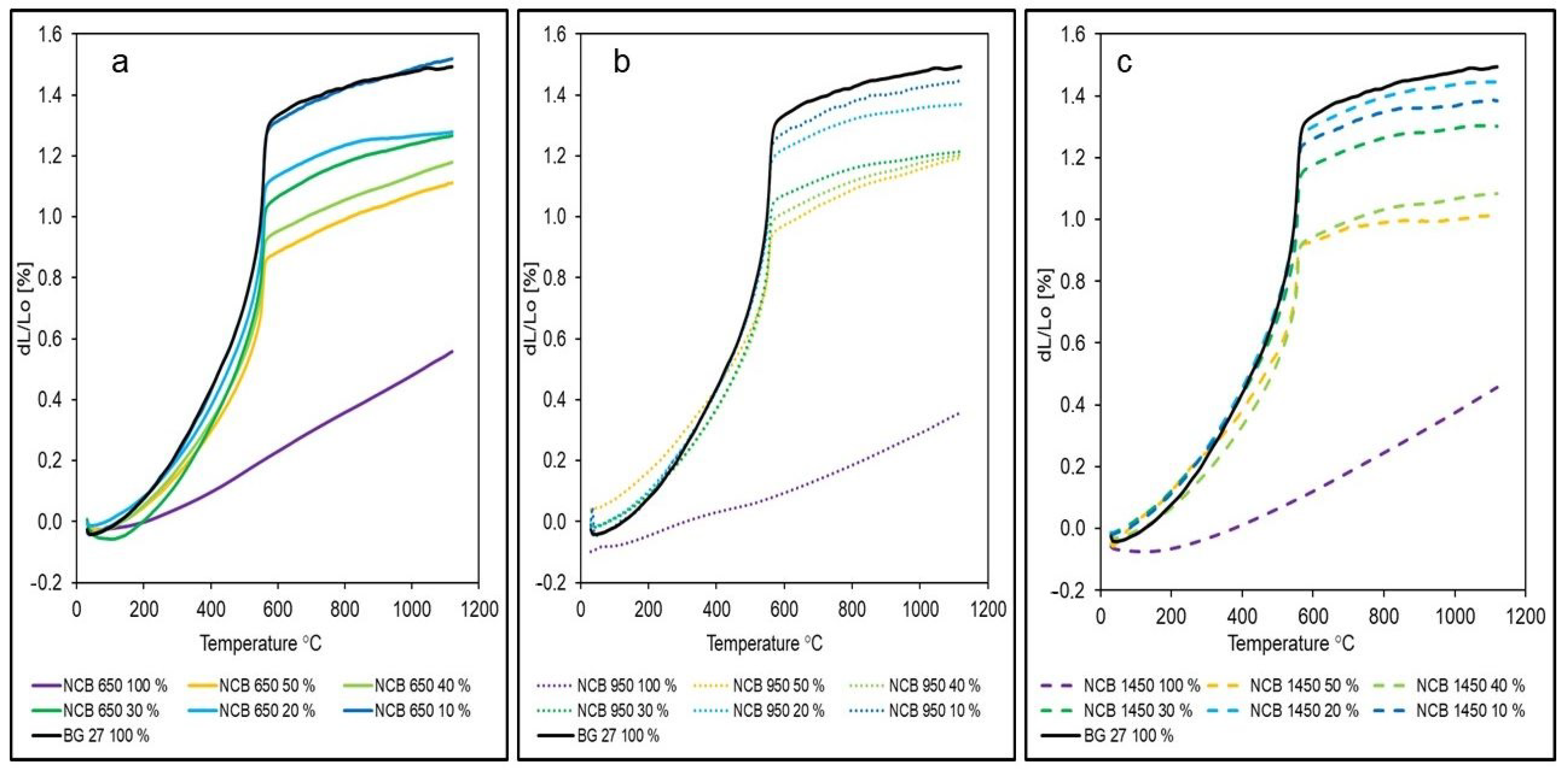Effect of the Composition of Hybrid Sands on the Change in Thermal Expansion
Abstract
1. Introduction
2. Materials and Methods
2.1. Sand Choice
2.2. Sample Preparation
2.3. Sand Evaluation
2.3.1. Powder Bulk Density and Sieve Analysis
2.3.2. Thermal Dilatation of the Sands
3. Results and Discussion
3.1. Sand Characterisation
3.2. Powder Bulk Density and Sieve Analysis
3.3. Thermal Dilatation of the Sands
4. Conclusions
Author Contributions
Funding
Institutional Review Board Statement
Informed Consent Statement
Data Availability Statement
Conflicts of Interest
References
- Campbell, J.; Svidró, J.T.; Svidró, J. Molding and Casting Processes. In ASM Handbook, Cast Iron Science and Technology; ASM International: Novelty, OH, USA, 2017; Volume 1A, pp. 189–206. [Google Scholar]
- Svidró, J.; Svidró, J.T.; Diószegi, A. The role of purity level in foundry silica sand on its thermal properties. In Journal of Physics Conference Series; IOP Publishing: Bristol, UK, 2020; Volume 1527, p. 012039. [Google Scholar]
- Kowalski, J.S. Thermal aspects of temperature transformations in silica sand. Arch. Foundry Eng. 2010, 10, 111–114. [Google Scholar]
- Anwar, N.; Sappinen, T.; Jalava, K.; Orkas, J. Comparative experimental study of sand and binder for flowability and casting mold quality. Adv. Powder Technol. 2021, 32, 1902–1910. [Google Scholar] [CrossRef]
- Chao, C.-H.; Lu, H.-Y. Stress-induced β→α-cristobalite phase transformation in (Na2O + Al2O3)-codoped silica. Mater. Sci. Eng. A 2002, 328, 267–276. [Google Scholar] [CrossRef]
- Molding Methods and Materials; Des Plaines, American Foundrymen’s Society: Schaumburg, IL, USA, 1962.
- Weddington, V.L.; Mobley, C.E. Influence of sand surface chemistry on bonding. AFS Trans. 1991, 99, 825–870. [Google Scholar]
- Gyarmati, G.; Budavári, I.; Fegyverneki, G.; Varga, L. The effect of sand quality on the bending strength and thermal distortion of chemically bonded sand cores. Heliyon 2021, 7, e07624. [Google Scholar] [CrossRef] [PubMed]
- Svidró, J.; Diószegi, A.; Tóth, L.; Svidró, J.T. The influence of thermal expansion of unbonded foundry sands on the deformation of resin bonded cores. Arch. Metall. Mater. 2017, 62, 795. [Google Scholar] [CrossRef]
- Ravi, S.; Thiel, J.; Bryant, N.; Giese, S.; Schneiter, T.J. Use of Dilatometry to Evalute the High Temperature Characteristics of Silica in Chromite Sand. In Proceedings of the 73rd World Foundry Congress (WFC 2018), Kraków, Poland, 23–27 September 2018; p. 447. [Google Scholar]
- Thiel, J.; Ziegler, M.; Dziekonski, P.; Joyce, S. Investigation into the Technical Limitations of Silica Sand Due to Thermal Expansion. Trans. Am. Foundry Soc. 2007, 115, 383–400. [Google Scholar]
- Břuska, M.; Beňo, J.; Cagala, M.; Jasinková, V. Dilatometric characterization of foundry sands. Arch. Foundry Eng. 2012, 12, 9–14. [Google Scholar] [CrossRef][Green Version]
- Bakhtiyarov, S.I.; Overfelt, R.A.; Wang, D. Thermophysical property measurements on mold materials: Thermal expansion and density. Int. J. Thermophys. 2005, 26, 141–149. [Google Scholar] [CrossRef]
- Svidró, J.T.; Diószegi, A.; Svidró, J.; Ferenczi, T. Thermophysical aspects of reclaimed moulding sand addition to the epoxy-SO2 coremaking system studied by Fourier thermal analysis. J. Therm. Anal. Calorim. 2017, 130, 1779–1789. [Google Scholar] [CrossRef]
- Thiel, J.; Ravi, S. Causes and solutions to veining defects in iron and steel castings. AFS Trans. 2014, 14, 1–16. [Google Scholar]
- Czerwinski, F.; Mir, M.; Kasprzak, W. Application of cores and binders in metalcasting. Int. J. Cast Met. Res. 2015, 28, 129–139. [Google Scholar] [CrossRef]
- Svidró, J.; Diószegi, A.; Svidró, J.T. The origin of thermal expansion differences in various size fractions of silica sand. Int. J. Cast Met. Res. 2020, 33, 242–249. [Google Scholar] [CrossRef]
- Thiel, J. Thermal expansion of chemically bonded silica sand. In AFS Proceedings; AFS Transactions-American Foundry Society: Schaumburg, IL, USA, 2011; pp. 1–10. [Google Scholar]
- Hrubovčáková, M.; Vasková, I.; Benková, M.; Conev, M. Opening material as the possibility of elimination veining in foundries. Arch. Foundry Eng. 2016, 16, 157–161. [Google Scholar] [CrossRef]
- Beňo, J.; Adamusová, K.; Merta, V.; Bajer, T. Influence of silica sand on surface casting quality. Arch. Foundry Eng. 2019, 19, 5–8. [Google Scholar]
- Ramrattan, S.; Wells, L.; Patel, P.; Shoemaker, J. Qualification of chemically bonded sand systems using a casting trial for quantifying interfacial defects. Int. J. Met. 2018, 12, 214–223. [Google Scholar] [CrossRef]
- Jelínek, P. Foundry Sand—Sand Mixtures Binder System; FTIS: Ostrava, Czech Republic, 2000; Volume 1, pp. 49–51. ISBN 80-238-6118-2. [Google Scholar]
- Thiel, J.; Ravi, S.; Bryant, N. Advancements in materials for three-dimensional printing of molds and cores. Int. J. Met. 2017, 11, 3–13. [Google Scholar] [CrossRef]
- Lauermannová, A.M.; Lojka, M.; Jankovský, O.; Faltysová, I.; Pavlíková, M.; Pivák, A.; Záleská, M.; Pavlík, Z. High-performance magnesium oxychloride composites with silica sand and diatomite. J. Mater. Res. Technol. 2021, 11, 957–969. [Google Scholar] [CrossRef]







| Sample Marking | Amount of Silica Sand [%] | Amount of Non-Silica Sand [%] |
|---|---|---|
| Biala Góra BG 27 | CERABEADS | |
| BG 27 100% | 100 | 0 |
| NCB 650 10% | 90 | 10 |
| NCB 650 20% | 80 | 20 |
| NCB 650 30% | 70 | 30 |
| NCB 650 40% | 60 | 40 |
| NCB 650 50% | 50 | 50 |
| NCB 650 100% | 0 | 100 |
| NCB 950 10% | 90 | 10 |
| NCB 950 20% | 80 | 20 |
| NCB 950 30% | 70 | 30 |
| NCB 950 40% | 60 | 40 |
| NCB 950 50% | 50 | 50 |
| NCB 950 100% | 0 | 100 |
| NCB 1450 10% | 90 | 10 |
| NCB 1450 20% | 80 | 20 |
| NCB 1450 30% | 70 | 30 |
| NCB 1450 40% | 60 | 40 |
| NCB 1450 50% | 50 | 50 |
| NCB 1450 100% | 0 | 100 |
| Retained [%] | |||||||
|---|---|---|---|---|---|---|---|
| Mesh Size [mm] | BG 27 100% | NCB 650 10% | NCB 650 20% | NCB 650 30% | NCB 650 40% | NCB 650 50% | NCB 650 100% |
| 0.710 | 0.04 | 0.05 | 0.02 | 0.03 | 0.11 | 0.01 | 0.05 |
| 0.500 | 0.60 | 0.39 | 0.43 | 0.36 | 0.35 | 0.25 | 0.04 |
| 0.355 | 10.19 | 9.27 | 8.73 | 8.42 | 7.04 | 5.60 | 0.07 |
| 0.250 | 31.17 | 23.54 | 27.41 | 27.31 | 26.05 | 25.69 | 16.30 |
| 0.180 | 29.22 | 34.90 | 31.96 | 33.16 | 33.51 | 35.28 | 40.11 |
| 0.125 | 22.55 | 25.97 | 24.68 | 24.37 | 25.33 | 26.90 | 34.29 |
| 0.090 | 4.65 | 3.90 | 4.64 | 4.18 | 4.53 | 4.82 | 6.44 |
| 0.063 | 0.97 | 0.99 | 1.10 | 1.19 | 1.05 | 1.23 | 1.98 |
| Pan | 0.34 | 0.19 | 0.20 | 0.18 | 0.19 | 0.09 | 0.10 |
| AFS number | 61 | 62 | 62 | 62 | 62 | 64 | 70 |
| d25 [mm] | 0.30 | 0.28 | 0.29 | 0.28 | 0.28 | 0.27 | 0.23 |
| d50 [mm] | 0.23 | 0.21 | 0.22 | 0.22 | 0.21 | 0.21 | 0.19 |
| d75 [mm] | 0.17 | 0.17 | 0.17 | 0.17 | 0.16 | 0.16 | 0.15 |
| Sorting coefficient S [%] | 57.6 | 59.8 | 58.3 | 59.2 | 59.1 | 60.8 | 65.7 |
| Log W [-] | 64.0 | 63.3 | 65.7 | 64.6 | 64.2 | 62.9 | 56.3 |
| Retained [%] | |||||||
|---|---|---|---|---|---|---|---|
| Mesh Size [mm] | BG 27 100% | NCB 950 10% | NCB 950 20% | NCB 950 30% | NCB 950 40% | NCB 950 50% | NCB 950 100% |
| 0.710 | 0.04 | 0.01 | 0.01 | 0.00 | 0.01 | 0.01 | 0.01 |
| 0.500 | 0.60 | 0.77 | 0.35 | 0.31 | 0.11 | 0.16 | 0.01 |
| 0.355 | 10.19 | 10.49 | 8.04 | 7.74 | 6.07 | 5.03 | 0.07 |
| 0.250 | 31.17 | 29.25 | 25.20 | 24.12 | 21.44 | 18.27 | 5.96 |
| 0.180 | 29.22 | 28.42 | 26.70 | 26.33 | 25.12 | 23.49 | 18.31 |
| 0.125 | 22.55 | 22.78 | 25.93 | 27.39 | 30.04 | 32.55 | 39.37 |
| 0.090 | 4.65 | 5.86 | 9.85 | 11.07 | 13.49 | 15.95 | 28.23 |
| 0.063 | 0.97 | 1.10 | 2.44 | 2.30 | 3.01 | 3.80 | 6.73 |
| Pan | 0.34 | 0.15 | 0.63 | 0.23 | 0.39 | 0.47 | 0.56 |
| AFS number | 61 | 62 | 68 | 69 | 73 | 77 | 92 |
| d25 [mm] | 0.30 | 0.30 | 0.28 | 0.28 | 0.26 | 0.25 | 0.18 |
| d50 [mm] | 0.23 | 0.22 | 0.21 | 0.20 | 0.19 | 0.17 | 0.14 |
| d75 [mm] | 0.17 | 0.17 | 0.15 | 0.15 | 0.14 | 0.13 | 0.11 |
| Sorting coefficient S [%] | 57.6 | 55.4 | 53.4 | 53.3 | 53.5 | 54.3 | 62.7 |
| Log W [-] | 64.0 | 66.5 | 69.3 | 69.7 | 66.9 | 70.1 | 60.5 |
| Retained [%] | |||||||
|---|---|---|---|---|---|---|---|
| Mesh Size [mm] | BG 27 100% | NCB 1450 10% | NCB 1450 20% | NCB 1450 30% | NCB 1450 40% | NCB 1450 50% | NCB 1450 100% |
| 0.710 | 0.04 | 0.01 | 0.07 | 0.02 | 0.01 | 0.01 | 0.01 |
| 0.500 | 0.60 | 0.34 | 0.45 | 0.27 | 0.17 | 0.25 | 0.03 |
| 0.355 | 10.19 | 8.83 | 8.97 | 7.53 | 5.49 | 5.77 | 0.02 |
| 0.250 | 31.17 | 27.52 | 25.61 | 23.10 | 18.87 | 16.15 | 0.05 |
| 0.180 | 29.22 | 26.24 | 23.40 | 20.72 | 18.01 | 14.86 | 0.31 |
| 0.125 | 22.55 | 25.83 | 26.21 | 28.06 | 32.52 | 35.12 | 57.50 |
| 0.090 | 4.65 | 8.95 | 12.76 | 17.34 | 21.27 | 23.56 | 36.53 |
| 0.063 | 0.97 | 1.15 | 1.82 | 2.26 | 3.05 | 3.61 | 4.40 |
| Pan | 0.34 | 0.31 | 0.21 | 0.22 | 0.37 | 0.20 | 0.24 |
| AFS number | 61 | 65 | 69 | 73 | 79 | 81 | 98 |
| d25 [mm] | 0.30 | 0.29 | 0.29 | 0.27 | 0.25 | 0.23 | 0.15 |
| d50 [mm] | 0.23 | 0.21 | 0.20 | 0.19 | 0.16 | 0.16 | 0.13 |
| d75 [mm] | 0.17 | 0.15 | 0.15 | 0.13 | 0.13 | 0.12 | 0.11 |
| Sorting coefficient S [%] | 57.6 | 53.5 | 50.9 | 49.3 | 50.7 | 51.7 | 72.4 |
| Log W [-] | 64.0 | 68.3 | 70.7 | 70.9 | 69.9 | 69.3 | 37.0 |
| Hybrid Mixture | Thermal Expansion Coefficient α [K−1] | Standard Deviation Sx |
|---|---|---|
| BG 27 100% | 1.407 × 10−5 | 1.636 × 10−6 |
| NCB 650 10% | 1.383 × 10−5 | 7.377 × 10−7 |
| NCB 650 20% | 1.181 × 10−5 | 4.350 × 10−7 |
| NCB 650 30% | 1.185 × 10−5 | 9.313 × 10−7 |
| NCB 650 40% | 1.111 × 10−5 | 2.285 × 10−7 |
| NCB 650 50% | 1.034 × 10−5 | 6.619 × 10−7 |
| NCB 650 100% | 5.446 × 10−6 | 6.406 × 10−7 |
| NCB 950 10% | 1.358 × 10−5 | 3.871 × 10−7 |
| NCB 950 20% | 1.270 × 10−5 | 4.249 × 10−7 |
| NCB 950 30% | 1.063 × 10−5 | 1.009 × 10−6 |
| NCB 950 40% | 1.081 × 10−5 | 5.741 × 10−7 |
| NCB 950 50% | 1.097 × 10−5 | 6.663 × 10−7 |
| NCB 950 100% | 4.202 × 10−6 | 1.575 × 10−8 |
| NCB 1450 10% | 1.302 × 10−5 | 1.005 × 10−6 |
| NCB 1450 20% | 1.359 × 10−5 | 2.799 × 10−7 |
| NCB 1450 30% | 1.254 × 10−5 | 1.177 × 10−6 |
| NCB 1450 40% | 1.067 × 10−5 | 7.854 × 10−7 |
| NCB 1450 50% | 9.112 × 10−6 | 2.851 × 10−6 |
| NCB 1450 100% | 5.192 × 10−6 | 1.099 × 10−6 |
Publisher’s Note: MDPI stays neutral with regard to jurisdictional claims in published maps and institutional affiliations. |
© 2022 by the authors. Licensee MDPI, Basel, Switzerland. This article is an open access article distributed under the terms and conditions of the Creative Commons Attribution (CC BY) license (https://creativecommons.org/licenses/by/4.0/).
Share and Cite
Radkovský, F.; Gawronová, M.; Merta, V.; Lichý, P.; Kroupová, I.; Nguyenová, I.; Kielar, Š.; Folta, M.; Bradáč, J.; Kocich, R. Effect of the Composition of Hybrid Sands on the Change in Thermal Expansion. Materials 2022, 15, 6180. https://doi.org/10.3390/ma15176180
Radkovský F, Gawronová M, Merta V, Lichý P, Kroupová I, Nguyenová I, Kielar Š, Folta M, Bradáč J, Kocich R. Effect of the Composition of Hybrid Sands on the Change in Thermal Expansion. Materials. 2022; 15(17):6180. https://doi.org/10.3390/ma15176180
Chicago/Turabian StyleRadkovský, Filip, Martina Gawronová, Václav Merta, Petr Lichý, Ivana Kroupová, Isabel Nguyenová, Šimon Kielar, Martin Folta, Josef Bradáč, and Radim Kocich. 2022. "Effect of the Composition of Hybrid Sands on the Change in Thermal Expansion" Materials 15, no. 17: 6180. https://doi.org/10.3390/ma15176180
APA StyleRadkovský, F., Gawronová, M., Merta, V., Lichý, P., Kroupová, I., Nguyenová, I., Kielar, Š., Folta, M., Bradáč, J., & Kocich, R. (2022). Effect of the Composition of Hybrid Sands on the Change in Thermal Expansion. Materials, 15(17), 6180. https://doi.org/10.3390/ma15176180







